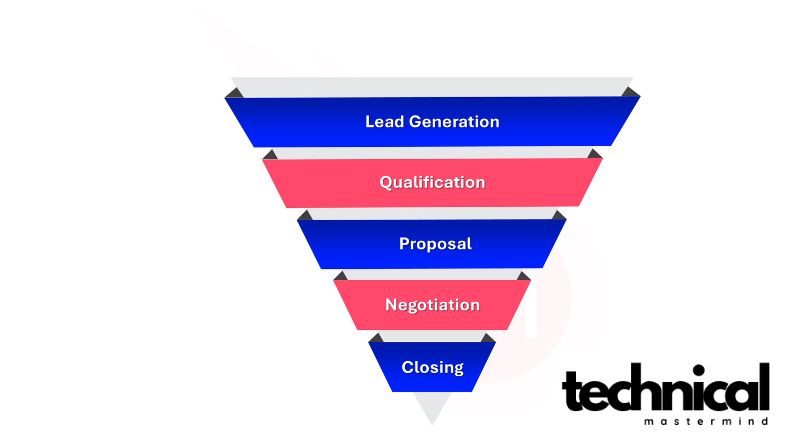The Dynamics of Effective Pipeline Management in Sales Teams
Sales pipeline management is one of the most crucial aspects of running a successful sales team. The “Dynamics of Effective Pipeline” can significantly determine the performance and output of a sales team, impacting how well leads are managed, tracked, and ultimately converted into paying customers. An efficient pipeline not only ensures that sales teams work strategically, but it also helps in forecasting future sales, improving team productivity, and driving revenue growth. In this article, we will delve into the key aspects of managing a sales pipeline effectively and explore best practices that can help enhance pipeline management in your sales organization.
Understanding the Sales Pipeline
A sales pipeline represents the process by which a lead is nurtured into a customer. The “Dynamics of Effective Pipeline” involves a series of stages that a potential customer moves through, from the initial point of contact to closing a deal. Understanding these stages is crucial for sales managers and their teams to ensure that leads are appropriately prioritized and opportunities are maximized.
The pipeline typically begins with lead generation, where marketing teams capture and qualify potential prospects. Once identified, these prospects move to the next stage: prospecting. During prospecting, the sales team reaches out to learn more about the leads’ needs, pain points, and potential fit for the product or service. Following that, leads enter the qualification stage, where a deeper understanding of their readiness to buy is developed. Finally, deals are closed, or in some cases, disqualified if they no longer fit the ideal customer profile.
Sales pipeline management is the art of managing these stages, ensuring that prospects are moved through efficiently and that no opportunities are missed. The key is to track every lead’s movement in the pipeline, identify where bottlenecks occur, and continuously optimize the process for higher conversion rates.
The Importance of Accurate Forecasting in Pipeline Management
An essential dynamic in effective pipeline management is accurate forecasting. Sales managers rely on pipeline data to predict future sales and set realistic goals for their teams. Without accurate forecasting, it becomes difficult to determine how much revenue is expected in the coming months or to allocate resources effectively.
By tracking metrics like the number of opportunities at each stage of the pipeline, the average sales cycle length, and the probability of closing each deal, sales teams can more accurately forecast their expected revenue. Accurate forecasting also helps identify potential gaps in the pipeline, allowing sales managers to take corrective actions before issues arise. It also provides valuable insights for long-term strategic planning, ensuring that the sales team can consistently meet or exceed targets.
Key Metrics for Monitoring Sales Pipeline Health
To ensure the success of the “Dynamics of Effective Pipeline,” it’s essential to monitor various key performance indicators (KPIs) that reflect the health and effectiveness of the pipeline. These metrics provide insights into how well the pipeline is functioning and where improvements may be necessary. Some of the most important KPIs to track include:
- Conversion Rate
The conversion rate measures the percentage of leads that move from one stage to the next. A low conversion rate at a particular stage may indicate a need for better qualification or a need to refine the messaging during outreach. - Sales Velocity
Sales velocity refers to how quickly leads move through the pipeline. High sales velocity means that deals are progressing faster, which can increase the overall efficiency of the sales process. Sales velocity can be influenced by factors such as the length of the sales cycle, the number of opportunities in the pipeline, and the average deal size. - Pipeline Value
The pipeline value represents the total value of all deals currently in the pipeline. This helps teams understand the potential revenue at any given moment and assess whether they are on track to meet their goals. - Lead-to-Opportunity Ratio
This metric tracks how many leads are turning into viable opportunities. A high ratio suggests that the sales team is doing a good job qualifying leads, while a low ratio may indicate that more effort is needed in the qualification process. - Win Rate
Win rate measures the percentage of opportunities that ultimately close as successful sales. A low win rate could signal that salespeople may need more training or better tools to close deals.
By consistently monitoring these KPIs, sales managers can stay informed about pipeline health and make adjustments as necessary to improve performance.
Best Practices for Managing the Sales Pipeline
Effectively managing the sales pipeline requires a blend of organization, communication, and proactive management. There are several best practices that can help sales teams optimize their pipeline management efforts:
- Regular Pipeline Reviews
Regularly reviewing the sales pipeline is one of the best ways to ensure that no opportunities are slipping through the cracks. Sales managers should schedule frequent pipeline review meetings with their teams to evaluate the status of each deal and discuss any potential obstacles. These meetings also provide an opportunity to reassess lead priorities and refine sales strategies as necessary. - Implementing a CRM System
Customer Relationship Management (CRM) tools are essential for tracking leads and managing the pipeline efficiently. A CRM allows sales teams to store and organize lead information, track communication history, set reminders for follow-ups, and gain insights into pipeline performance. This visibility into the pipeline helps sales teams stay organized and ensures that important tasks are not overlooked. - Segmenting the Pipeline
Not all opportunities in the pipeline are equal, so it’s important to segment the pipeline based on criteria such as lead source, deal size, or likelihood of closing. By categorizing opportunities, sales teams can better prioritize their efforts and focus on the most promising leads. This segmentation also allows sales managers to identify patterns and tailor their strategies based on different customer needs. - Nurturing Leads Throughout the Sales Cycle
Pipeline management is not just about closing deals; it’s about guiding leads through the sales process with personalized attention and relevant content. Sales teams should use nurturing tactics, such as follow-up emails, product demos, or educational content, to keep leads engaged and move them further down the pipeline. The goal is to build trust and demonstrate the value of the product or service at every touchpoint. - Set Clear Goals and Expectations
Setting clear goals for each stage of the sales pipeline is essential for keeping the team focused and accountable. Goals can include the number of opportunities to qualify, the amount of pipeline revenue to generate, or the number of deals to close within a given period. These goals should be realistic, measurable, and aligned with overall sales objectives.
Overcoming Common Challenges in Pipeline Management
Despite the best efforts, managing a sales pipeline comes with its challenges. Sales teams may encounter issues such as:
- Lead Quality: Sometimes, sales teams spend too much time on unqualified leads, resulting in wasted resources. To overcome this, teams should focus on improving lead scoring systems to better identify high-quality leads.
- Pipeline Stagnation: Deals may stall at certain pipeline stages, particularly if there is a lack of communication or if the salesperson isn’t actively working to move the deal forward. Regular follow-ups and pipeline reviews can help keep deals progressing.
- Forecasting Errors: Sales forecasting can sometimes be inaccurate, leading to missed targets or misallocation of resources. Ensuring that all sales activities are tracked and up-to-date in a CRM can help mitigate forecasting issues.
By identifying these common challenges and proactively addressing them, sales teams can enhance the “Dynamics of Effective Pipeline” and improve the overall performance of the pipeline.
Conclusion
The “Dynamics of Effective Pipeline” in sales is about more than just moving leads through stages—it’s about optimizing every part of the process to create a streamlined, efficient pipeline that maximizes conversions. Accurate forecasting, constant monitoring of key metrics, and implementing best practices are essential for ensuring that your sales team performs at its best. By adopting these strategies and consistently refining the sales pipeline, sales managers can ensure a higher level of success and help their teams reach their targets more effectively.
Effective pipeline management isn’t a one-time effort but an ongoing process that requires attention, flexibility, and a commitment to continuous improvement. By keeping the pipeline healthy and well-organized, sales teams can achieve greater success in driving revenue and growth for the organization.
May Also Read: technicalmasterminds














Post Comment